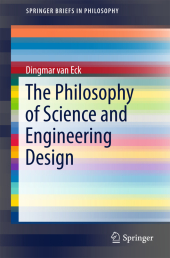 Neuerscheinungen 2016Stand: 2020-02-01 |
Schnellsuche
ISBN/Stichwort/Autor
|
Herderstraße 10
10625 Berlin
Tel.: 030 315 714 16
Fax 030 315 714 14
info@buchspektrum.de |

Dingmar van Eck
The Philosophy of Science and Engineering Design
2016. ix, 75 S. 9 SW-Abb., 9 Tabellen. 235 mm
Verlag/Jahr: SPRINGER, BERLIN 2016
ISBN: 3-319-35154-0 (3319351540)
Neue ISBN: 978-3-319-35154-4 (9783319351544)
Preis und Lieferzeit: Bitte klicken
This book discusses the relationship between the philosophy of science and philosophy of engineering, and demonstrates how philosophers of engineering design as well as design researchers can benefit from the conceptual toolkit that the philosophy of science has to offer.
In this regard, it employs conceptual tools from the philosophical literature on scientific explanation to address key issues in engineering design and philosophy of engineering design. Specifically, the book focuses on assessing the explanatory value of function ascriptions used in engineering design and philosophy of technical functions; on elaborating the structure of explanation in engineering design; on assessing the role and value of design representations in engineering design and philosophy thereof; and on elaborating means for the testing of design methods.
Presenting a novel and effective approach to tackling key issues in the field, philosophers of engineering and design alike will greatly benefit from this book.
Introduction
Chapter 1: Function ascription and explanation: elaborating an explanatory utility desideratum for ascriptions of technical functions
1 Introduction 2 Functional vs. teleological explanation: why was artifact x produced? 2.1. The ICE theory of technical functions 2.2. Heuristics of technical function ascriptions 3 Malfunction explanation 3.1 malfunction analysis: an engineering example 4 Conclusions
Chapter 2: Mechanistic Explanation in Engineering Science
1 Introduction 2 Mechanistic explanation in engineering science 2.1 Mechanistic explanation and (role) functional individuation 2.2 Function and functional decomposition in engineering 2.3 Reverse engineering explanation (and redesign) 2.4. Malfunction explanation 2.5 Capturing mechanistic explanation in engineering science: pluralism about mechanistic role functions 3 Explanation and systems thinking: where engineering and systems biology meet 3.1 Engineering and mechanistic explanation in system biology: the e.coli heat shock case 4 Explanatory power: Rethinking the explanatory desiderata of ´abstraction´ and ´completeness and specificity´ 4.1. Explaining robustness: complete and specific models 4.2 malfunction explanation: local specificity and global abstraction 4.3 malfunction explanation in biology
Chapter 3: Dissolving the ´problem of the absent artifact´: design representations as means for counterfactual understanding and knowledge generalization
Introduction 1 The problem of the absent artifact 2 Dissolving the problem of the absent artifact 3 Roles of design representations 3.1 Explanation and counterfactual understanding 3.2 Abstraction, idealization, generalization, and unification 4 Conclusion
Chapter 4: On testing engineering design methods: explanation, reverse engineering, and constitutive relevance
1 Introduction 2 Mechanistic explanation: explanation by decomposition 2.1. Mechanistic explanation 3 Mutual manipulability and the causal-constitutive relevance distinction 3.1. Mutual manipulability 3.2. Fat-handedness and mutual manipulability combined 4. Testing (reverse) engineering design methods: applying mutual manipulability 4.1 Mechanistic reverse engineering explanation 4.2 Testing case 4.3 The goodness of design representations 5 Outlook and conclusions


